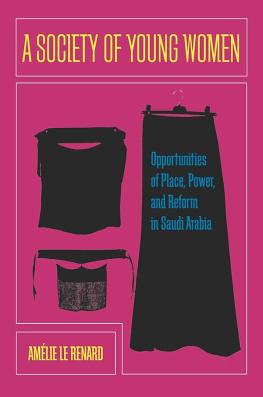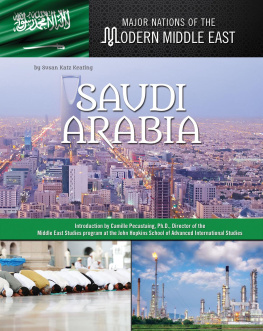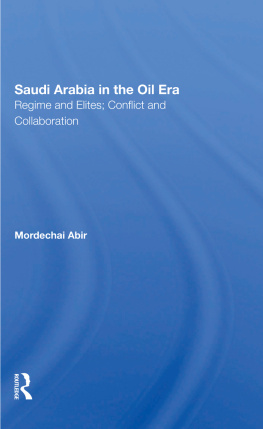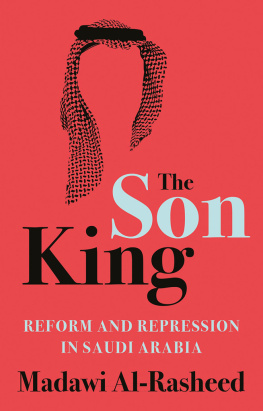Amélie Le Renard - A Society of Young Women: Opportunities of Place, Power, and Reform in Saudi Arabia
Here you can read online Amélie Le Renard - A Society of Young Women: Opportunities of Place, Power, and Reform in Saudi Arabia full text of the book (entire story) in english for free. Download pdf and epub, get meaning, cover and reviews about this ebook. year: 2014, publisher: Stanford University Press, genre: Home and family. Description of the work, (preface) as well as reviews are available. Best literature library LitArk.com created for fans of good reading and offers a wide selection of genres:
Romance novel
Science fiction
Adventure
Detective
Science
History
Home and family
Prose
Art
Politics
Computer
Non-fiction
Religion
Business
Children
Humor
Choose a favorite category and find really read worthwhile books. Enjoy immersion in the world of imagination, feel the emotions of the characters or learn something new for yourself, make an fascinating discovery.
- Book:A Society of Young Women: Opportunities of Place, Power, and Reform in Saudi Arabia
- Author:
- Publisher:Stanford University Press
- Genre:
- Year:2014
- Rating:5 / 5
- Favourites:Add to favourites
- Your mark:
- 100
- 1
- 2
- 3
- 4
- 5
A Society of Young Women: Opportunities of Place, Power, and Reform in Saudi Arabia: summary, description and annotation
We offer to read an annotation, description, summary or preface (depends on what the author of the book "A Society of Young Women: Opportunities of Place, Power, and Reform in Saudi Arabia" wrote himself). If you haven't found the necessary information about the book — write in the comments, we will try to find it.
Amélie Le Renard: author's other books
Who wrote A Society of Young Women: Opportunities of Place, Power, and Reform in Saudi Arabia? Find out the surname, the name of the author of the book and a list of all author's works by series.
A Society of Young Women: Opportunities of Place, Power, and Reform in Saudi Arabia — read online for free the complete book (whole text) full work
Below is the text of the book, divided by pages. System saving the place of the last page read, allows you to conveniently read the book "A Society of Young Women: Opportunities of Place, Power, and Reform in Saudi Arabia" online for free, without having to search again every time where you left off. Put a bookmark, and you can go to the page where you finished reading at any time.
Font size:
Interval:
Bookmark:
Stanford University Press
Stanford, California
2014 by the Board of Trustees of the Leland Stanford Junior University.
All rights reserved.
A version of this work was originally published in French in 2011 under the title Femmes et espaces publics en Arabie Saoudite [Women and Public Spaces in Saudi Arabia] 2011, Dalloz, Paris.
No part of this book may be reproduced or transmitted in any form or by any means, electronic or mechanical, including photocopying and recording, or in any information storage or retrieval system without the prior written permission of Stanford University Press.
Printed in the United States of America on acid-free, archival-quality paper
Library of Congress Cataloging-in-Publication Data
Le Renard, Amlie, author.
A society of young women : opportunities of place, power, and reform in Saudi Arabia / Amlie Le Renard.
pages cm
Includes bibliographical references and index.
ISBN 978-0-8047-8543-3 (cloth : alk. paper)
ISBN 978-0-8047-8544-0 (pbk. : alk. paper)
1. Young womenSaudi ArabiaSocial conditions. 2. Urban womenSaudi ArabiaSocial conditions. 3. Public spacesSocial aspectsSaudi Arabia. I. Le Renard, Amlie. Femmes et espaces publics en Arabie Saoudite. Based on (work): II. Title.
HQ1730.L423 2014
305.242'209538dc23
2014007324
ISBN 978-0-8047-9137-3 (electronic)
Typeset by Bruce Lundquist in 10/15 Minion Pro
A SOCIETY OF YOUNG WOMEN
Opportunities of Place, Power, and Reform in Saudi Arabia
AMLIE LE RENARD
STANFORD UNIVERSITY PRESS
STANFORD, CALIFORNIA
CONTENTS
PREFACE
When I began my research in Riyadh in 2005, I knew little about the way in which postcolonial feminist scholars had deconstructed and problematized Western discourses on gender in the Middle East. I was already committed to the struggle against the occupation of Palestinian territories and felt concerned more broadly about issues of imperialism in the Middle East. I was deeply critical
from the policies and media discourses of Western countries. If we ignore this dimension, it is impossible to understand why this debate is so vivid in Saudi Arabia.
Journalists prolific but politically problematic interest in Saudi women contrasts with the silence in France of many renowned specialists on the Middle East, who when I began my research did not recognize gender as a legitimate subject and mainly dealt with men in their own research. I had to defend my gender approach adamantly. A few academics told me that though they considered the gender approach irrelevant in general, they thought it was appropriate when dealing with Saudi Arabia. Here, I must make it clear that I am definitely opposed to this notion. I do not regard Saudi society as some kind of exception, or seek to other it as backward because of its sexism, a discourse that has problematic resonance with the colonial one. On the contrary, my contention is that it is high time to de-exceptionalize Saudi society and study it like any other society, marked by contradictions and tensions. I also strongly refute developmentalist perspectives that regard womens condition as the path of progress from tradition to modernity, with some countries more advanced and others backward. In this discourse, when applied to Saudi Arabia, it is often implied that the king is progressive and society is conservative. A far more complex picture emerges from a study of the contradictory policies concerning Saudi womens mobility and activities, the vivid debates around them, and the actual practices of the women themselves. One of my aims has been to understand the sociological, historical, and political conditions that have led to the spatial economy of gender that I have analyzed in Riyadhthat is, the organization of public spaces based on the segregation of men from women. Projects promoting Saudi womens progress away from tradition that can be justified by various normative references (religion, nation, modernity, womens rights in Islam) are objects of my analysis, rather than its guiding framework.
As I was conducting this research, the reactions of different persons to the themes I dealt with revealed the extreme stereotypes circulating about Saudi society. I often had the feeling that people who would never express generalities about racial minorities, and who define themselves as nonracists, did not hesitate to formulate very general negative statements about Saudis. Against stereotypes, ethnographic description opens perspectives on diverse and complex moments and interactions, personal situations and subjectivities. As with any other place, Riyadhs inhabitants are situated in multiple ways, face dilemmas, and experience contradictions. Religion or culture do not in themselves define them, nor do they determine their behavior. Likewise, being a woman is never an isolated status: while the category of gender is necessary to analyze any society, Saudi women are also the subjects of an authoritarian and repressive monarchy. Their lives are deeply impacted, in ambivalent ways, by the rapid transformations of Saudi capitalism. For instance, while shopping malls have become highly popular spots for womens sociability, some experience consumerism as a constraint that limits their mobility by excluding them, because they cannot, for example, purchase designer-brand clothing or do not want to wear makeup. They occupy specific positions, not only in the power relations of gender, class, and age, but also in rural/urban, sedentary/bedouin, and national/nonnational hierarchies. Although Saudi Arabia is often described as a closed society, the population includes many nonnational men and women (one-third of the big cities inhabitants), and most Saudi households actually employ and house nonnational maids. Non-Saudis are not a focus of this book, but it is impossible to understand the status and situations of Saudi women without taking into account this enormous group of nonnationals living in proximity to Saudis. Notwithstanding the minority status of Saudi women, as women, vis--vis Saudi men, they are relatively privileged, as subjects of the monarchy, compared with most non-Saudi female residents, who experience different expectations, constraints, and limits. Recent employment policies promote the replacement of nonnationals by Saudi citizens. In order to understand why Saudi society is often represented as closed in spite of the huge numbers of nonnational residents, we must look at the politics of multiple spatial segregations and rituals of noninteraction.
of Place, Power, and Reform in Saudi Arabia is much shorter than its French original, with ethnographic passages now made central to the narrative.
Conducting ethnographical fieldwork in a context so different from my society of origin led me to a particularly strong personal engagement and a questioning of elements that had previously seemed obvious to me. My ethnographic experience of women-only), while men still interacted with me in the same way as before, as a lady, because I was veiled in front of them.
However, although I socialized with various groups in Riyadh, I am not Saudi and I do not pretend to speak in the name of Saudi women or Saudi feminists. Neither do I seek to participate in the Western discourse on womens oppression in Saudi Arabia, which I think does not help the cause, is imperialistic, and selects its victims accordingly. It rarely, for example, speaks of the regular flash protests by groups of Saudi women since 2011, especially against the detention without trial of thousands of people suspected of being linked to terrorist networks. It also ignores, in general, nonnational women living in Saudi Arabia, excluding them from its scope. I hope that my analysis of transforming Saudi femininities, which explores complex processes in terms of changing norms, hierarchies, and power relations, will help point out the flaws in the assumptions on which this Western discourse is based.
Next pageFont size:
Interval:
Bookmark:
Similar books «A Society of Young Women: Opportunities of Place, Power, and Reform in Saudi Arabia»
Look at similar books to A Society of Young Women: Opportunities of Place, Power, and Reform in Saudi Arabia. We have selected literature similar in name and meaning in the hope of providing readers with more options to find new, interesting, not yet read works.
Discussion, reviews of the book A Society of Young Women: Opportunities of Place, Power, and Reform in Saudi Arabia and just readers' own opinions. Leave your comments, write what you think about the work, its meaning or the main characters. Specify what exactly you liked and what you didn't like, and why you think so.









